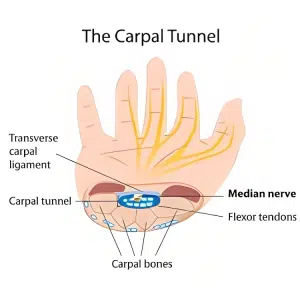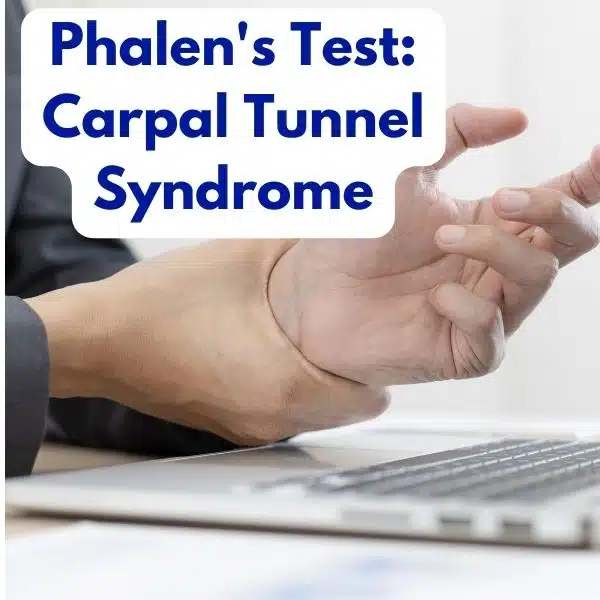Carpal tunnel syndrome (CTS) is a common condition affecting the wrist and hand. Compression of the median nerve as it passes through the wrist causes it. CTS symptoms include hand and finger pain, numbness, and tingling. Phalen’s test is a basic examination that can aid in the diagnosis of CTS.
The median nerve is in control of the feeling and movement of the thumb and the majority of the fingers. When the median nerve is compressed or constricted near the wrist, it can cause symptoms such as pain, tingling, numbness, and weakness in the hand and fingers. Repetitive hand motions, wrist injuries, arthritis, diabetes, pregnancy, or thyroid issues can all contribute to CTS.

Phalen’s test is a simple and rapid test that can aid in the diagnosis of CTS by inducing symptoms of median nerve compression. Dr. George S. Phalen first defined it in 1957, and it is now frequently utilized by doctors and physiotherapists.
In this blog post, we’ll look at what Phalen’s test is, how it’s done, and how accurate and specific it is.
What is Phalen’s Test?
The Phalen’s test is performed by flexing both wrists at 90 degrees for 60 seconds and looking for pain or paresthesias (burning, tingling, or numbness) in the median nerve innervated fingers. The thumb, index finger, middle finger, and half of the ring finger are included. The test can be modified by applying direct pressure to the median nerve at the carpal tunnel level.
The rationale behind Phalen’s test is that wrist flexion increases the pressure in the carpal tunnel and compresses the median nerve between the transverse carpal ligament and the anterior border of the distal end of the radius. This triggers or worsens CTS symptoms in those who are affected.
What are Some Indications for Phalen’s Test?
Phalen’s test is recommended for
- Individuals who have CTS symptoms such as pain, numbness, and tingling in their hands and fingers,
- A history of previous CTS, or surgery for CTS.
- Risk factors for CTS, such as repetitive hand motions, wrist injuries, arthritis, diabetes, pregnancy, or thyroid disorders.
To aid in the diagnosis of CTS, the test can be administered during a physical examination. It is a low-risk, non-invasive assessment that may be completed quickly and easily in a clinical context.
(You May Like Ramsay Hunt Syndrome: Click Here)
What are the Contraindications for Phalen’s Test?
Phalen’s test is a physical examination technique used to assess for the presence of carpal tunnel syndrome.
There are some contraindications to performing Phalen’s test, including:
- Recent wrist or hand surgery or injury
- Severe arthritis of the wrist or hand
- Known or suspected nerve damage or neuropathy in the wrist or hand
- Pregnancy – pregnant women may experience mild to moderate symptoms of carpal tunnel syndrome due to hormonal changes, but Phalen’s test may exacerbate these symptoms and cause unnecessary discomfort.
How to Perform Phalen’s Test?
1. Standard Phalen’s Test
The standard Phalen’s test is performed by placing the patient’s flexed elbows on a table and allowing their wrists to fall into maximal flexion. The patient is asked to press the dorsal surfaces of their palms together for 30-60 seconds.
The patient is requested to describe any symptoms that arise during or during the examination. The examiner may also look for changes in skin color or hand warmth.
2. Reverse Phalen’s Test
The reverse Phalen’s test is similar to the Phalen’s test in that the wrist is held in extension rather than flexion. The reverse Phalen’s test, like Phalen’s test, can mimic the symptoms of CTS in patients.
3. Modified Phalen’s Test
Modified Phalen’s test is a variant of Phalen’s test that involves flexing the wrist and putting direct pressure on the median nerve. When the standard Phalen’s test is unclear or the patient has an anatomical variation that can impair the accuracy of the standard test, this modification is utilized.
Positive Phalen’s Test
A positive Phalen test occurs when the patient’s usual CTS symptoms are reproduced during the test. This finding indicates that the patient has CTS. A positive test, however, does not confirm the diagnosis of CTS. To confirm the diagnosis, another diagnostic test such as nerve conduction studies or electromyography may be required.
Sensitivity and Specificity of Phalen’s Test
For diagnosing CTS, Phalen’s test has a sensitivity of 75-85% and a specificity of 80-90%. This suggests that the test is relatively accurate, but it can occasionally yield false-positive or false-negative results. Patients with diseases that mimic CTS, such as cervical radiculopathy or thoracic outlet syndrome, may have false-positive results. In patients with mild or early-stage CTS, false-negative outcomes are possible.
LR+: 2.68
LR-: 0.54
What to Do If Phalen’s Test Is Positive?
If Phalen’s test results are positive, you have a high risk of having CTS. It does not, however, confirm the diagnosis because other illnesses can give identical symptoms. As a result, you should seek further examination and therapeutic intervention from your doctor or physiotherapist.
Other tests, such as nerve conduction studies or electromyography, may be performed by your doctor or physiotherapist to confirm CTS. They can also ask about your medical history, lifestyle, and work-related issues that may contribute to CTS.
Depending on the degree and origin of your CTS, your doctor or physiotherapist may recommend one of the following treatments:
- Wearing a wrist splint at night or during activities that make your discomfort worse
- Taking pain relievers or anti-inflammatory drugs
- Changing your workplace or routines to decrease wrist strain
- Exercising or stretching to enhance wrist mobility and strength
- Receiving massage or manual therapy to reduce nerve compression
- Getting steroid injections to alleviate carpal tunnel inflammation
- Having surgery to decompress the median nerve and relieve the transverse carpal ligament
The goal of treatment is to alleviate your symptoms while avoiding future nerve damage. Early detection and treatment can significantly improve your prognosis and quality of life.
What are Some Other Tests for Carpal Tunnel Syndrome?
Other tests, in addition to Phalen’s, can aid in the diagnosis of CTS. These include:
Tinel’s sign: This is performed by tapping the median nerve at the wrist and feeling for tingling or electric shock-like sensations in the median nerve distribution.
The carpal compression test: It involves applying direct pressure to the carpal tunnel for 30 seconds and looking for symptoms in the median nerve distribution.
Scratch collapse test: This includes scratching one side of the carpal tunnel and checking for a momentary lack of resistance to an internal rotation force applied to both arms.
Nerve conduction studies: It entails monitoring the speed with which electrical signals move along the median nerve from electrodes placed on the skin.
Electromyography: This involves inserting fine needles into muscles innervated by the median nerve and recording their electrical activity.
In conclusion, Phalen’s test is a simple and useful examination that can aid in the diagnosis of CTS. It has high sensitivity and specificity for diagnosing CTS, but it can produce false-positive or false-negative results in some cases. If you are experiencing symptoms of CTS, talk to your healthcare provider about whether Phalen’s test is appropriate for you.
References
- Phalen GS. Carpal tunnel syndrome. Clinical orthopedics and related research. 1972; 83:29-40.
- Skirven T, Osterman A, Fedorczyk J, Amadio P. Rehabilitation of the hand and upper extremity. Philadelphia: Elsevier Health Sciences; 2011.
- Keith MW. American Academy of Orthopaedic Surgeons clinical practice guideline on the diagnosis of carpal tunnel syndrome. The Journal of Bone and joint surgery American Volume. 2009; 91(10):2478-9.
- Huisstede BM, Coert JH, Fridén J, Hoogvliet P. Carpal tunnel syndrome: hand surgeons, hand therapists, and physical medicine and rehabilitation physicians agree on a multidisciplinary treatment guideline-results from the European HANDGUIDE study. Physical therapy. 2014; 94(10):1443-53.
- Understanding Leptospirosis: A Comprehensive Guide to Animal Health in 2024
- Ultimate Guide to Life Expectancy of PNH Disease and Key Factors: Mastering PNH Understanding
- Understanding Hunter Syndrome: A Comprehensive Guide to a Rare Genetic Disorder in 2024
- Pentasomy X Syndrome: A Comprehensive Guide for Patients and Researchers in 2024
- Tips for Getting Better Sleep with Anxiety in 2024
